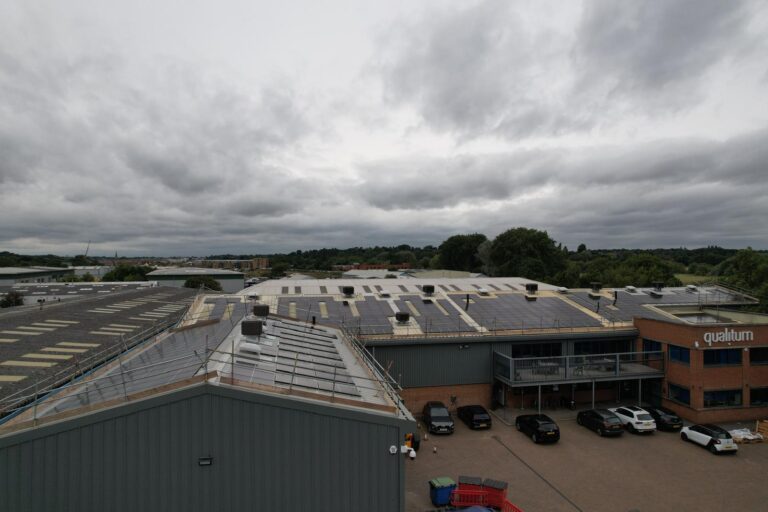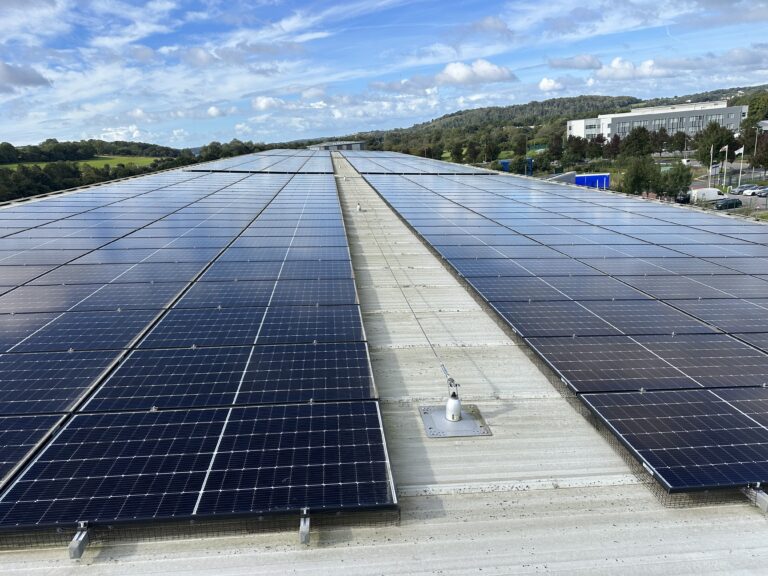Monocrystalline Solar Panels: A Comprehensive Guide
Monocrystalline solar panels are widely recognised for their superior efficiency, durability, and long-term performance, making them a preferred choice for commercial and industrial applications. These panels are manufactured from a single crystal of silicon, allowing for a more efficient energy conversion process. Their efficiency typically ranges from 18% to 24%, significantly outperforming polycrystalline alternatives. This guide explores the characteristics, advantages, and costs of monocrystalline solar panels, as well as their installation, maintenance, and a comparison with polycrystalline options to help you make an informed decision.
What is a Monocrystalline Solar Panel?
A monocrystalline solar panel is a type of photovoltaic (PV) panel made from a single continuous crystal structure of silicon. This manufacturing process gives the panel a uniform appearance, typically with a sleek black finish. The single-crystal composition allows for a more streamlined movement of electrons, enhancing overall performance and reliability.
Compared to polycrystalline panels, which are made from multiple silicon fragments, monocrystalline panels are known for their durability, longevity, and high-quality construction, making them a preferred choice for various applications.

How Do Monocrystalline Solar Panels Work?
Monocrystalline solar panels operate by converting sunlight into electricity through the photovoltaic effect. This process ensures a reliable and renewable energy source for various applications. The process involves several key steps:
Electron Excitation:
These photons transfer energy to electrons, causing them to move and generate an electric current.
Absorption of Sunlight:
The silicon cells in the panel absorb photons from sunlight, initiating the energy conversion process.
Electricity Generation:
The direct current (DC) electricity is captured and directed through an inverter, converting it into usable alternating current (AC) power.
Power Distribution:
The electricity can then be used immediately to power electrical devices, fed into the grid, or stored in batteries for later use.
Monocrystalline Solar Panel Efficiency
Efficiency is a critical parameter when evaluating solar panel performance. Monocrystalline solar panels exhibit efficiency ratings ranging from 18% to 24%, positioning them as the most efficient commercially available photovoltaic (PV) technology. Their superior efficiency stems from several key factors:
Single-Crystal Structure:
The uniform silicon lattice minimises grain boundaries, allowing for optimal electron mobility, reducing resistance, and mitigating energy losses.
Higher Energy Density:
These panels generate greater electrical output per unit area, making them particularly advantageous for installations with spatial constraints.
Enhanced Performance in Low-Light Conditions:
Monocrystalline panels exhibit superior photon absorption and charge carrier transport, ensuring better energy production in diffuse sunlight, overcast conditions, and suboptimal irradiation environments.

Monocrystalline vs. Polycrystalline vs. Bifacial Solar Panels
Choosing the right commercial solar panel type is essential for optimising energy efficiency, cost, and long-term performance. Below, we compare monocrystalline, polycrystalline, and bifacial solar panels, highlighting their key features and benefits.
|
Feature |
Monocrystalline Panels |
Polycrystalline Panels |
Bifacial Panels |
|
Efficiency |
18% – 24% |
14% – 18% |
Up to 33% |
|
Material |
Single crystal silicon |
Multiple silicon fragments |
Dual-sided 12BB solar cells with transparent back |
|
Performance in Low Light |
High |
Moderate |
Very High |
|
Space Efficiency |
Higher |
Lower |
Highest |
|
Lifespan |
25+ years |
20-25 years |
25+ years |
|
Cost |
Higher |
Lower |
Higher (but higher yield) |
|
Aesthetic Appeal |
Black, uniform look |
Blue, fragmented look |
Transparent back enhances aesthetics |
|
Additional Energy Yield |
N/A |
N/A |
Up to 33% more energy capture |
Why Consider Bifacial Monocrystalline Solar Panels?
Bifacial solar panels maximise energy generation by capturing sunlight from both the front and the back. Their transparent back design with 12BB solar cells and 91.5% light transmittance allows them to absorb reflected sunlight from surfaces like rooftops, the ground, or even water bodies. Compared to traditional commercial solar pv panels, they can generate up to 33% more energy, making them an ideal choice for businesses and large-scale solar farms.
If you’re looking for maximum efficiency, space-saving benefits, and long-term returns, bifacial solar panels could be the best investment for your renewable energy needs.
Cost and Monocrystalline Solar Panel Price
The energy output of a monocrystalline solar panel is influenced by multiple factors, including wattage rating, solar irradiance, geographic location, ambient temperature, shading, and installation angle. Under optimal conditions:
A 500W panel can produce 1.5 - 2.0 kWh per day under similar conditions.
A 450w monocrystalline solar panel generates approximately 1.2 - 1.5 kWh per day, assuming peak sun hours of 4-5 hours.
Annually, a 450W panel yields 438 - 550 kWh, though actual performance varies based on seasonal fluctuations, panel orientation, and local weather patterns.
Cost and Monocrystalline Solar Panel Price
The price of monocrystalline solar panels for commercial installations varies depending on factors such as brand, wattage, system scale, and installation complexity. In the UK, commercial solar panel systems typically range from £650 to £950 per kW installed, with larger commercial solar panel installations benefiting from economies of scale. A 50 kW system may cost between £32,500 and £47,500, while a 250 kW system can exceed £200,000.
Factors influencing commercial solar panel pricing include:
Brand and Quality:
Premium brands provide longer warranties and enhanced performance.
Panel Wattage:
Higher wattage commercial solar panels cost more but improve overall energy yield.
Installation Costs:
Larger-scale installations involve structural assessments, mounting systems, and grid connection fees.
Warranties:
Panel dependant, up to 30-year warranties available with SunPower Maxeon panels up to 40 years combined product and power warranty.
Government Incentives:
UK businesses can leverage tax relief, capital allowances, and grants to offset initial investment costs.
Best Monocrystalline Solar Panels in the UK
Several Solar PV manufacturers produce high-performance monocrystalline solar panels suited for commercial and industrial applications. The top-rated options available in the UK include:
✅ SunPower Maxeon 6 – Industry-leading efficiency of up to 22.8%, ensuring maximum energy yield.
✅ REC Alpha pure 460wp – Renowned for its superior durability, high output, and advanced cell technology. 22.6% efficiency.
✅ Q Cell 500wp – Optimal yields, whatever the weather with excellent low-light and temperature behaviour.
✅ Trina Solar Vertex S – Offers high power output at a competitive price.
✅JA Solar DeepBlue 3.0 – A well-balanced choice combining efficiency, reliability, and cost-effectiveness for large-scale commercial solar panel installations.
✅ Polysolar BIPV Flexible Panels – A wide range of different solar BIPV glass technologies with efficiency levels up to 20%

Advantages of Monocrystalline Solar Panels
Monocrystalline solar panels offer superior performance, making them a preferred choice for businesses seeking long-term energy solutions. Their key advantages include:
Space-Saving:
Ideal for commercial rooftop solar installations and compact areas due to their high-power output.
High Efficiency:
Generate more electricity per square meter, maximising energy production.
Durability:
Engineered for longevity, with warranties often extending 25 years or more.
Aesthetic Appeal:
The sleek, uniform black design enhances visual integration with commercial and industrial buildings.
Better Performance in Low Light:
Deliver consistent output, even on overcast days.
Disadvantages of Monocrystalline Solar Panels
While monocrystalline solar panels offer superior efficiency and durability, they also come with certain drawbacks:
Fragility:
Susceptible to damage from severe impacts, requiring careful handling and installation.
Higher Cost:
More expensive than polycrystalline panels, making initial investment higher.
Manufacturing Waste:
The production process involves significant silicon wastage, increasing material costs and environmental impact.
Performance Sensitivity:
Efficiency may decrease in extremely high temperatures compared to some other solar technologies.
Conclusion
Monocrystalline solar panels are the preferred option for commercial PV installations, offering exceptional efficiency, durability, and space-saving benefits. While they come with a higher upfront cost, their long lifespan and reliable performance make them a valuable investment for businesses, especially those with limited roof space or diverse light conditions. In the UK, commercial enterprises can maximise their return on investment by exploring the best monocrystalline solar panels and leveraging available government incentives and tax rebates, further enhancing the financial benefits of solar energy.
